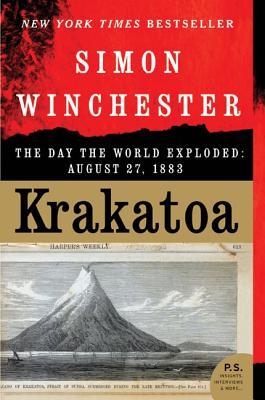 Natural disasters hold a fascination for me, just as they do for many others. They're terrible in the destruction they wreak, sometimes on a global scale, and yet it's hard to look away. And of course the underlying forces behind the disasters are fascinating in their own right. Volcanoes are one of the biggest cases of natural disasters, and among them the name "Krakatoa" has its own sort of mystique.
Natural disasters hold a fascination for me, just as they do for many others. They're terrible in the destruction they wreak, sometimes on a global scale, and yet it's hard to look away. And of course the underlying forces behind the disasters are fascinating in their own right. Volcanoes are one of the biggest cases of natural disasters, and among them the name "Krakatoa" has its own sort of mystique.
Like many others, I first encountered Krakatoa in the children's book The Twenty-One Balloons. I don't remember a lot about the story, except that it involed a group of Europeans who lived on a volcanic island in the Pacific (the island was misplaced in the book; Krakatoa was actually located in the Indian Ocean in the Sunda Straight) who had crazy houses, and had to flee on a big balloon platform and parachute down to the new places they wanted to live when the volcano that loomed over the island exploded. All these years later, when I wanted a nonfiction palate cleanser from a particular book hangover I was suffering (thank you, Hunted), I decided that the real story of Krakatoa would be a good candidate.
But the thing is, not a heck of a lot is actually known about Krakatoa. Not many people within distance of actually witnessing its explosion survived; instead, all but a handful were killed by the massive tsunamis (up to a hundred feet high) that pummeled the coasts of both Java and Sumatra and killed probably thirty-five thousand people--only about a thousand died from the usual volcanic killers, such as pyroclastic flows. But these figures, again, mean that there aren't a lot of witnesses. Instead, witnesses were limited to a handful of survivors who outran tsunamis (very impressive) and were on ships large enough to ride out the perilous seas in the wake of the eruption. In addition, not enough was known about volcanology in the late nineteenth century to really document the causes of the eruption. And, unfortunately, Krakatoa was almost entirely destroyed in the eruption, leaving behind only half of one of its three peaks. So, while another island has begun to emerge (called the Son of Krakatoa) there's not enough of the original left for modern geologists to examine it for potential insights about the famed eruption.
Because of these informational deficits, Winchester bulks out his volume with some of the history of Indonesia, though only its colonial parts. The focus here is very much on the Dutch colonizers, barely touching on the native population at all except to mention local superstitions about volcanoes and one chapter about the growing resistance that spread in the wake of Krakatoa's eruption, which probably contributed to the resistance (though saying that the eruption caused the resistance, as Winchester muses at one point, is probably a stretch). He also explains the history of botany in the region and a larger chunk of the book is contributed to a history and explanation of the theory (in this use, theory being fact, as it is used in science) of plate tectonics. Some of this was interesting, and I think it probably is needed in some form for a book of this nature, but the sheer amount of page time devoted to it seemed a bit excessive when a simpler explanation could have accomplished the same understanding.
Then there's the writing. Some of it is vivid and engaging. Some of it is dry as dirt and I found myself skimming paragraph after paragraph. There doesn't actually appear to be much rhyme or reason to when the writing is good and when it's a bit rough, either. The good and bad parts both appear in all parts of the book, in all topics. The drier bits do seem to have some issues with structure, which seems to be an editing problem or at least a problem that should have been weeded out during editing; they're frequently confusing in how they're written and there are a lot of weird paragraph breaks that didn't seem to really be necessary. And one big thing did bother me: I had no idea where Krakatoa actually was. This book has a wealth of illustrations, photographs, diagrams, and maps, but despite all of that I found myself pulling up Google Maps to figure out where all of this was actually taking place--Krakatoa not being labelled on any of the wider maps of the region, and not enough specificity being given for me to envision it without a proper map.
Still, the story of this remarkable mountain was intriguing, enough to have me neglecting another book to read it. That said, you have to go into it with the awareness that the portion about the eruption itself and its direct consequences is not very long at all. I'm pretty used to this from history books, which never seem to focus as much on their titular subjects as one would think, but I can definitely see it bothering others, so reader beware in that respect.
4 stars out of 5.
No comments:
Post a Comment